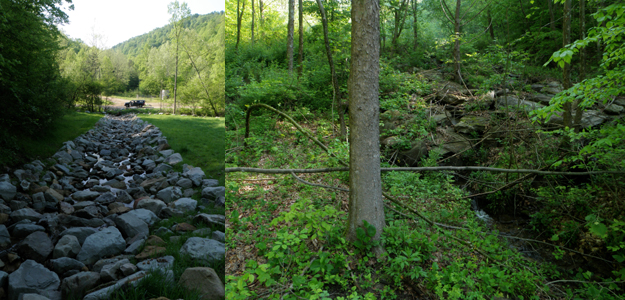Reforming loose legal definitions of ecological restoration
Laws allowing open interpretation of ecological restoration undermine sound science in the recovery of self-sustaining living communities.

What makes a stream? Clearly defining ‘restoration’ in law. An Appalachian project with the narrow goal of restoring stream flow after mountaintop mining, (left) delivers few of the resources of the natural ecosystem that was lost (right). Photo credit: Emily Bernhardt.
Though mandates like the Clean Water Act have been powerful tools for instituting environmental protections in the United States, loose legal definitions of “restoration” mean that few mitigation projects install whole, functioning, and self-sustaining ecosystems. Likewise, programs aimed at recovery of endangered species do not necessarily prioritize the recovery of functional ecosystems to support them. Ecologist Margaret Palmer and legal scholar JB Ruhl examine the scientific and (US) legal bases for ecological restoration, considering how the two may be more fruitfully unified in “Aligning restoration science and the law to sustain ecological infrastructure for the future,” on page 512 of ESA Frontiers November 2015 (open access) special issue on “Preparing for climate change — infrastructure and other innovations.”
Palmer, director of the Socio-Environmental Synthesis Center (SESYNC), and Ruhl, director of Vanderbilt University’s Program on Law and Innovation received ESA’s 2016 Sustainability Science Award for this effort to review the legal basis for restoration, identify unintended consequences of imprecise policies, and offer solutions. They describe valid ecological restoration projects, which either remove sources of destruction or mitigate their effects by actively influencing the biophysical processes that make the local ecological communities self-sustaining, and conclude with pathways to creating national best practices and minimum standards for restoration projects.
Margaret A Palmer and JB Ruhl (2015). Aligning restoration science and the law to sustain ecological infrastructure for the future. Frontiers in Ecology and the Environment 13: 512–519. http://dx.doi.org/10.1890/150053